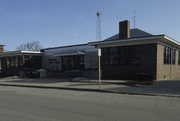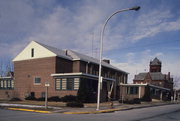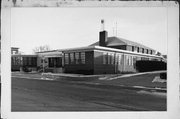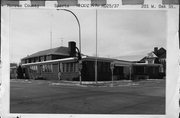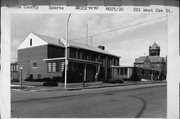Property Record
201 W OAK ST
Architecture and History Inventory
| Historic Name: | Camp McCoy USO Recreation Club |
|---|---|
| Other Name: | Sparta City Hall |
| Contributing: | Yes |
| Reference Number: | 27970 |
| Location (Address): | 201 W OAK ST |
|---|---|
| County: | Monroe |
| City: | Sparta |
| Township/Village: | |
| Unincorporated Community: | |
| Town: | |
| Range: | |
| Direction: | |
| Section: | |
| Quarter Section: | |
| Quarter/Quarter Section: |
| Year Built: | 1943 |
|---|---|
| Additions: | |
| Survey Date: | 1989 |
| Historic Use: | recreational building/gymnasium |
| Architectural Style: | Other Vernacular |
| Structural System: | |
| Wall Material: | Brick |
| Architect: | Johnson and Kramer |
| Other Buildings On Site: | |
| Demolished?: | No |
| Demolished Date: |
| National/State Register Listing Name: | Water Street Commercial Historic District |
|---|---|
| National Register Listing Date: | 11/12/1992 |
| State Register Listing Date: | 7/3/1992 |
| National Register Multiple Property Name: |
| Additional Information: | The Camp McCoy USO Recreation Club Building was erected in 1943. In 1942-1943, at the height of World War II, the U,S, Army decided to build a USO center in Sparta to support the troops at Camp McCoy and needed a building for the center. The city hall, which had been housed in a former Baptist church at this location was offerred to the government, if the new USO could be turned back into a city hall after the war. With this agreement, the U.S. Army razed the Baptist Church building there and built the present day brick structure at the southwest corner of West Oak and South Court Streets. At this time, Dr. Hugh Williams was mayor. There was little dispute over the need for this building. The only controversy was ove whether the outside walls should be made of tile with brick facing. Evidently, a deal was worked out with the U.S. Army whereby the city paid for the brick facing for the building in order to have the right to assume the building after World War II. Thereafter, the building was constructed. The new Camp McCoy USO replaced a temporary one at a home on the northeast corner of East Oak and South Benton Streets. The original USO, as constructed, contained four club rooms, a kitchen, a locker room, and social hall. The building cost approximately $100,000. In 1946, after World War II, the Army offerred the building to the City of Sparta and after some negotiations, the city took over the building. The City of Sparta paid the Federal Works Agency somewhere between $27,500 and $35,000 for the former USO center. Now, it is the West Oak Street City Hall. The Camp McCoy USO Recreation Club building gains local historical significance under Criterion A in association with the topic of federal Government under Sparta's Government Theme. The building's period of signifciance ranegs from 1943 to 1946, when it was used as a USO recreation building and was associated with Camp McCoy. This building meets the criteria for properties constructed during the 50 year non-historic period. Located on the southwest corner of Oak and Court Streets, this red brick one-story building features a hip roofed gymnasium surrounded by one-story flat roofed extensions on the east, west and north [facade] sides of the building. The building is characterized by overhanging wooden eaves or cornices with wooden frieze boards. The brick elevations of the gymnasium are divided vertically by regularly spaced applied pilasters. This former recreational building is characterized further by a centrally located recessed entrance bay flanked by the east and west wings. A brick end chimney rises above the roof line in the center of the north elevation of the hip roofed gymnasium section behind the one-story entrance bay. The one-story brick extensions also feature groups of rectangular windows with multiple horizontally divided lights. The windows form a band on the east, west, north facades as well as on the brick elevations of the inside walls of the two front wings flanking the recessed facade. The main entrance located on the recessed facade features a double leafed door and is covered by a cantilevered canopy. A concrete porch accessed by a short flight of stairs leads to the main entrance. Two side entrances are located on the east elevations and one side entrance to the gym is located on the west elevation. The interior displays a beige fireplace wall and hearth ornamented by inlaid brick at the rear [south wall] of the main lounge or community room and maple floors. A gynasium [also with maple floor] is located at the rear of the building and city offices are located around the perimeter of the community room and gynasium located in the center of the building. This former USO club building has been altered only by the reuse of its attending offices and rooms as city offices while maintaining the presence of the gymnasium and the lounge and fireplace [community room]. In addition, the main entrance on the facade was altered by the addition of new doors and stucco to the brick wall flanking the entrance. The wooden letters of the "Federal Rcreational Building" sign has been removed from the cornice above the entrance on the recessed facade. Built in 1943 for a total cost of $95,000, this building was constructed by Johnson and Kramer of St. Charles, Minnesota. The construction was supervised by Grady Stone, a construction engineer with the Federal Works Agency. Built as a USO Club to serve the military stationed at nearby Fort McCoy, this building, originally planned as a frame building, was built of brick and tile at the request of the City of Sparta. The extra funds for brick construction were raised by the citizens of Sparta by popular subscription. The USO Club was dedicated September 18, 1943. A baby grand piano for the stage was purchased with the surplus funds raised by Sparta for the brick construction. This building was built on the site of the 1896 brick First Baptist Church, which had been remodeled as the Sparta City Hall in 1914 according to plans drawn by A.E. Parkinson [La Crosse, WI], and of two frame houses located on the south part of the lot, which were moved to L Street and Blake Street. In 1946, it was purchased by the City for use as its City Hall. The Camp McCoy USO Recreation Building is significant under Criterion C as an example of a transitional late Classical Revival influenced public building. This building is an exception to the NRHP criteria that a building must be 50 years of age mainly because of its historical importance. In addition, this well-preserved 1943 building is the first governmental public building constructed in Sparta since the post office in 1915. |
|---|---|
| Bibliographic References: | (A) Monroe County History Room, Rt. 2, Sparta, WI, Photograph Collection, Photograph #105. (B) "A Centennial Portfolio," Sparta Herald June 6, 1983 (photograph). (C) Sparta Herald Aug. 18, 1896; Dec. 22, 1914; March 8, 1943; March 29, 1943; April 5, 1943; April 19, 1943; Aug. 23, 1943; Sept. 6, 1943; Sept. 20, 1943; March 8, 1953. (D) Sanborn Insurance Maps 1184, 1889, 1894, 1900, 1911, 1922, 1931. (E) City of Sparta, WI, Community Development Office, City Files. (F) City of Sparta, "Tour Historical Downtown Sparta: A Self-Guided Tour." Unpublished Pamphlet. (G) City of Sparta: City Council Minutes for Sept. 22, 1942 and March 2, 1943. (H) Sparta Local History Room: Photographic Album of Sparta Hotels, Depots and Buildings, and Photographic Album of Sparta, Wisconsin. (I) Sparta Centennial Celebration Committee, Sparta Incorporation City Centennial, 1883-1983 (1983), Unpublished Pamphlet, p. 51. (J) Middlemam, Julia E., "Summary of Sparta School History, 1852-1980: With Bits of Early Sparta History." (1980) Typescript, pp. 2 amd 10. |
| Wisconsin Architecture and History Inventory, State Historic Preservation Office, Wisconsin Historical Society, Madison, Wisconsin |

